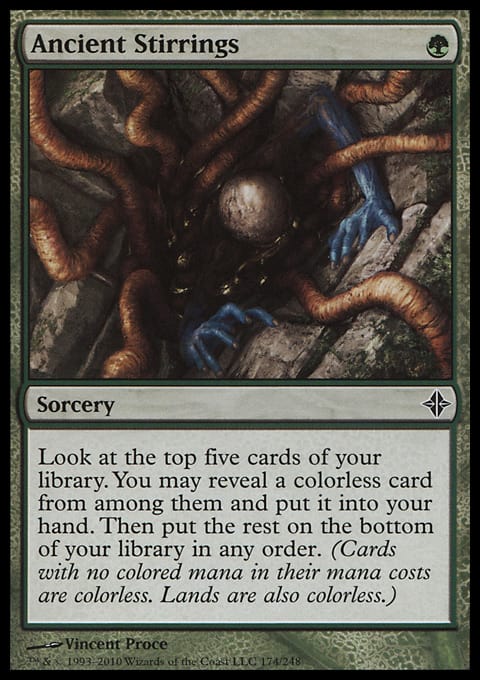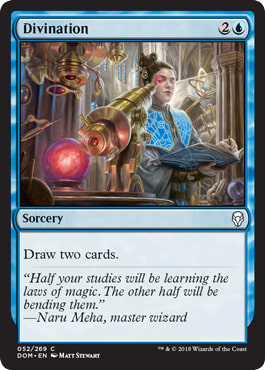In this experiment, we try out a 1-mana variant that can augment any format.
The word cantrip in Magic has long referred to a spell or effect that draws a card. Kavu Climber is a cantrip because of its enters-the-battlefield ability. Dismiss is a Counterspell cantrip. Defiant Strike is a cantrip that’s a combat trick.
However, the origin of the term, as far as Magic is concerned, is for small spells, the effects of which are so small that they aren’t even worth 1 mana. Thus, they also have the text, “Draw a card.” But why are they called cantrips?
Well, in Dungeons & Dragons, wizards and other spell-casting classes can learn spells of various levels. The higher the level of the spell, the more powerful it is. But for doing small things, such as slightly altering voices, engaging in parlor tricks, or expressing small levels of telekinesis, there were cantrips. These were spells of the lowest level—spells that could be cast more frequently and with much less preparation than the higher-level spells.
A spell of that class is rarely useful in an all-combat game of Magic: The Gathering. But when Wizards of the Coast printed low-mana spells with minor effects—so low in power that, “Draw a card,” was tacked on—those cards were named for the small scope of their effects.
Somehow, over time, the term cantrip came to describe effects that draw a card rather than those that are so small that the drawing of a card must be tacked on.
In Dungeons & Dragons terms, Kavu Climber, as a medium-sized creature that requires a good amount of preparation to summon, would definitely not be a cantrip. Defiant Strike, on the other hand, could very well fit the bill.
But what does any of this have to do with the format variant I promised in my intro?
“Draw a Card”
Some of the fairest Magic occurs when each player draws one card each turn, casts spells, and faces off with creatures. Some of the unfairest Magic occurs when a players runs away with Ancestral Recalls, Prime Speaker Zeganas, or a multitude of Jeskai Ascendancy triggers.
When a player draws a ton of cards, things can get out of hand quickly. It’s all those darned cantrips.
So my idea was, “What if we replace all of what we’re calling cantrips with what cantrip was actually meant to mean?” What I ended up with doesn’t actually answer that question, but it hints at it. Let’s take a look.
Basically, if we determine that drawing so many cards is unfair, what if we replace drawing so many cards with actually performing actions. In normal Magic, every card represents an action, but each costs an amount of mana to enact. It turns out that mana can be circumvented or shrugged off as not-too-prohibitive. So, let’s force players to perform actions that are worth the same amount of mana as drawing a card.
An actual cantrip is the non-draw effect of a 1-mana spell that also draws a card (such as the 1-damage prevention of Bandage or the flight-granting of Cloak of Feathers), so using actual cantrip effects would be pretty boring. Instead, let’s replace players’ card-draws with the effects of 1-mana spells.
Here’s the basic rule of my Cantrip variant:
And that’s pretty much it. The variant takes any format and makes it a lot more ground-level. Players can’t just draw a ton of cards from their own decks and go off. Draws are replaced by immediate spells, making the gameplay a bit more proactive. But the cantrip deck is a stack of various cards, so it also makes the gameplay pretty random. But as fans of Chaos Magic and Planechase know, random isn’t necessarily a bad thing.
That said, I think the variant could be even more interesting with a little more consistency. It also makes the variant take up some more table space, but the idea is that after a cantrip (a card from the cantrip deck) is drawn and resolved, instead of going to a singular cantrip graveyard, it goes to one of five cantrip graveyards: one for each color.
And whenever a player would draw from the cantrip deck (to replace a draw and cast a 1-mana spell), that player can instead to choose to cast the top card of any cantrip graveyard stack that matches the color of the effect he or she is using to draw a card. But a player can’t cast any one cantrip more than once in a turn.
Thus, if a player cast Kavu Climber to cast a spell from cantrip deck, and the card drawn from the cantrip deck were Ancient Stirrings, Ancient Stirrings would go to the green cantrip graveyard after it resolved. If that player then cast another Kavu Climber during that same turn, the player wouldn’t be able to choose Ancient Stirrings because he or she has already cast that cantrip that turn. The player would have to draw a new cantrip.
But if the player had drawn Cloudshift as his or her first cantrip and Ancient Stirrings had already been cast and resolved previously in the game, leaving it on top of the green cantrip graveyard, the player could resolve Cloudshift on Kavu Climber, triggering its enters-the-battlefield again, then allowing the player the choice again to either draw a new cantrip or cast the Ancient Stirrings (since it’s the top of the green cantrip graveyard). The player would not be able to choose Cloudshift from the white cantrip graveyard because Kavu Climber is green, not white, and thus its card-draw trigger effect isn’t of the requisite color for Cloudshift.
Having the five different graveyards has the downside of board complexity and can make things a bit tougher to handle, so feel free to try the one-graveyard variant first. But different players will be playing different colors, and so they’ll be able to pay attention to just the stacks relevant to them. And allowing players the option of casting a known, predictable spell can take away some of the frustration that can show up with randomized effects. A card such as Argivian Find might be useless to a player, so he or she can avoid the risk of having to draw such an effect by just using the red cantrip graveyard for the hypothetical Shock on top.
Anyway, here’s the list I made, but feel free to draw up your own cantrip deck.
Cantrip Deck ? The Cantrip Variant | Andrew Wilson
- White (10)
- 1 Ajani's Presence
- 1 Argivian Find
- 1 Cloudshift
- 1 Divine Light
- 1 Faith's Shield
- 1 False Peace
- 1 Festival of Trokin
- 1 Funeral Pyre
- 1 Hope Charm
- 1 Swift Justice
- Blue (10)
- 1 Aerial Formation
- 1 Pongify
- 1 Piracy Charm
- 1 Prismatic Lace
- 1 Retraction Helix
- 1 Sleight of Hand
- 1 Spy Network
- 1 Taunt
- 1 Twiddle
- 1 Unsummon
- Black (10)
- 1 Appetite for Brains
- 1 Dark Ritual
- 1 Disentomb
- 1 Disfigure
- 1 Duress
- 1 Ebony Charm
- 1 Ghastly Demise
- 1 Stabbing Pain
- 1 Vampire's Bite
- 1 Vile Rebirth
- Red (10)
- 1 Assault Strobe
- 1 Blazing Salvo
- 1 Blinding Flare
- 1 Burning Cloak
- 1 Burst of Speed
- 1 Chaos Charm
- 1 Coordinated Assault
- 1 Forked Bolt
- 1 Shock
- 1 Smelt
- Green (10)
- 1 Ancient Stirrings
- 1 Burst of Strength
- 1 Caravan Vigil
- 1 Commune with Nature
- 1 Emerald Charm
- 1 Explosive Growth
- 1 Might of Old Krosa
- 1 Nature's Panoply
- 1 Sprout
- 1 Sylvan Tutor
Formats
As a variant, it can be used in basically any format. I think Commander would be the best place to start. If you play a lot of Commander, you’ve probably encountered some players with some commanders who just seem to draw too many cards. Playing Cantrip Commander could refresh a play group as a once-per-night alternative.
Another interesting option is Cube. A heavily curated, powered Cube probably won’t benefit from Cantrip. It could be interesting—in the same way Cantrip Commander might be—but I just don’t think carefully-drafted decks of powerful and streamlined cards would greatly benefit from the randomness of Cantrip.
But a Cube that I think would be more enhanced by Cantrip would be a Pauper Cube. When the cards and decks are of a generally lower power level, the occasional card-draw turning into potentially potent effects could create very interesting gameplay. My only concern is that the Pauper Cube in question may not have enough draw effects to begin with.
Thus, a play group that really enjoys Cantrip and wants to maximize it should probably use a Pauper—or otherwise non-powered—Cube with card selections made specifically to enhance the variant. It’s important to remember that a lot of cards completely change gears in Cantrip context. Most of the cards I selected target creatures, so players will want to have creatures on the battlefield and be ready to go aggressive. Sitting back behind Divinations won’t work when a Divination turns into a Might of Old Krosa and an Assault Strobe instead of letting you draw a card. You have to be ready to be proactive to avoid wasting your draw-a-card effects.
So, this is pretty divergent from what I normally write about, and on top of that, Cantrip is a pretty out-there idea. What do you think of a variant that prevents giant hand sizes and crazy draw-related combos? It’s not for everyone, and it’s not for all the time, but let me know what you think in the comments.
Andrew Wilson
fissionessence at hotmail dot com





























